- Bernard Preston homepage
- Our green garden
- Do Lima Beans Need to Climb
Do lima beans need to climb?
Do lima beans need to climb and what sort of trellis is required? What helps them grow and is direct sunlight needed?
There are bush varieties that will bear much sooner but are far less prolific.
There should be a few climbing lima beans growing in every garden. They need a trellis of sorts to cling to. They are planted in spring and go on bearing for months from April into July in the mild Southern Hemisphere climate. They will provide an excellent source of vegetable protein right through the winter; off the ground they are relatively frost resistant.
Limas have a very deep rooting system so they are less reliant on regular watering like broad beans need. Nevertheless it’s good to have both; they have different benefits. Grow them in full sun.
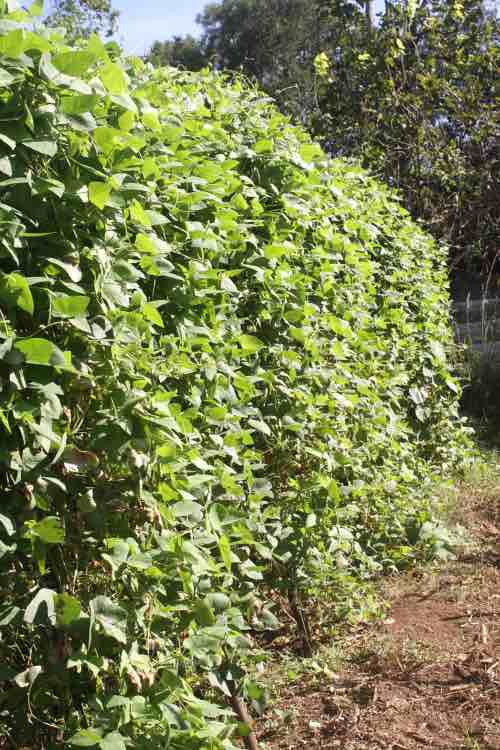 Do lima beans need to climb?
Do lima beans need to climb?We favour the green lima over its purple-speckled cousin; it’s less chewy and has a wonderful if mild flavour. The seeds are not easy to get. In cans they are called butter beans.
There’s a story to be told. My father now long dead was an American; he brought back a few packets of seed of the green variety after visiting his parents. They were quite difficult to germinate and of the 40 only two grew; one was taken by a cutworm. Today we enjoy thousands every year, the offspring from that single plant. It has become acclimatised to the soil and weather in our village and thrives.
In spring build a trellis once the ground is soft after the first rains and the danger of frost is over. We did it for decades with bamboo largely I suppose because it was free; but the canes only last one year. It is quite a fag cutting them, building the frame and taking down the rotten remains at the end of the season. So now we use "intingus."
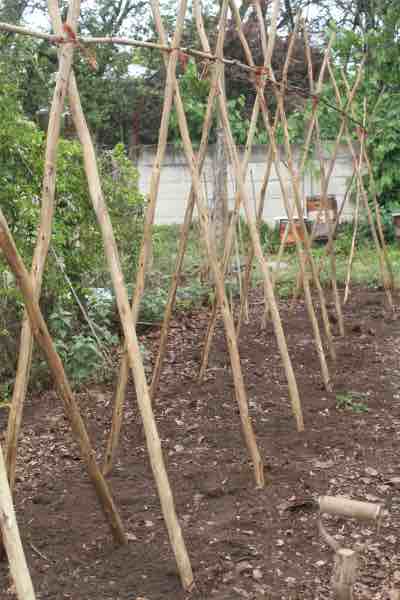 Lima bean trellis of wattle poles; intingus in South Africa
Lima bean trellis of wattle poles; intingus in South AfricaDig holes into the ground about a metre apart, at least 30cm deep and press the poles deeply into the soil; compact it. In the V formed about 2m above ground run another preferably longer intingu. Tie everything firmly with twine. The young vines have difficulty clinging to the smooth wattle so we also press in any old bamboo canes too; they don’t need to be strong.
The seeds need to be soaked between two layers of damp newspaper; keep them moist but not wet. They tend to rot. After a few days press one on either side of each intingu into the soil. Germination remains a problem and you will have to be ready to put in more after say two weeks if no little shoot appears.
Guide them up the poles, if necessary tying them with twine; and hooking them so they grow ever upwards or they droop to the ground with the weight of the vine.
Limas have a very long growing season; three months or more but will then go on bearing right through the winter if you can water them. Each plant will produce hundreds of beans; keep some for planting the following spring.
Some watering may be necessary in you have a harsh winter; deep mulching with autumn leaves will save you a lot of time and effort.
Folate
Folate is a very important B vitamin, absolutely essential from conception to the grave. A deficiency during pregnancy causes severe birth defects; tiredness from anaemia and early frailty.
The vitamin is required for protein metabolism; a deficiency causes a build up of toxic homocysteine. One cup of limas provides nearly half of your daily need.
There is a strong correlation with achievement in school.
Protein
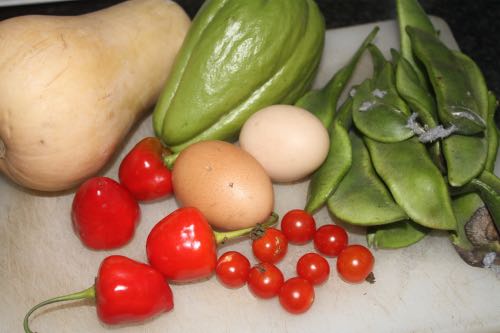
1 cup of cooked lima beans contains about 12 grams of protein, about a quarter of an adult’s needs; nearly sufficient for a small child. But it is not complete; some essential amino acids are missing. An egg, glass of milk or meat is necessary to prevent kwashiorkor.
Choline
Choline really should be called a vitamin; it’s absolutely essential for health and 90% of those eating typical grocery store food are deficient.
Lima beans have many other virtues; google them. We have enjoyed them daily since the beginning of April; they will continue for about four months. They take about five minutes to cook; a veritable pantry of vegetable protein daily for a third of the year. Every family should be growing and enjoying them. We often use them in a “shakshuka;” a crazy mixed-up dish.
Don’t buy your food; grow it if you can! The only cost is the sweat off your brow.
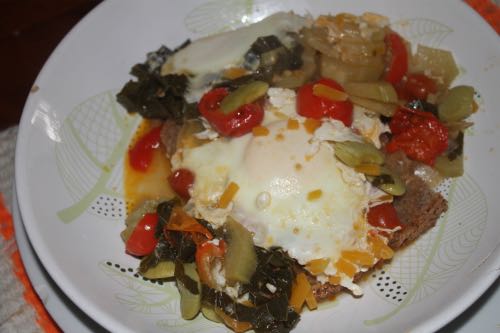 Lima bean shakshuka on toast
Lima bean shakshuka on toastDo lima beans need to climb?
Do lima beans need to climb and how long does it take for the plant to produce a crop?
Climbing beans in general are my first choice; they produce a much larger crop but they take about 3 months before they start bearing.
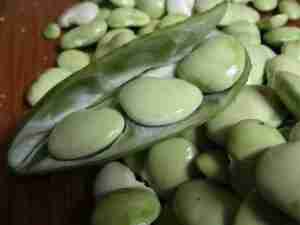
Are lima beans starchy?
There are many myths about dieting; one of them is that legumes are all starchy and you must avoid them for ever. Whilst a cup of limas does contain about 40 grams of carb most of it is either fibre (6g) or of the resistant type.
They have a low glycemic index; much of that carb passes through to the colon where instead of producing glucose it feeds the microbiome.
It is in any case our contention that it is the refined carbs, particularly sugar and white flour that make us obese; that's the place to start if wanting to lose weight, not the healthy starches like legumes.
The next step is this lima bean soup. First make a bouillon from vegetable scraps.
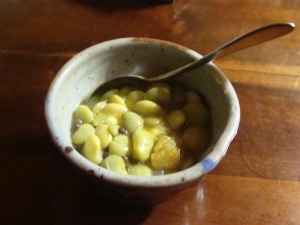
When browsing use right click and "Open Link in New Tab" or you may get a bad gateway signal.
Newsletter
Our newsletter is entitled "create a cyan zone" at your home, preserving both yourself and Mother Earth for future generations; and the family too, of course. We promise not to spam you with daily emails promoting various products. You may get an occasional nudge to buy one of my books.
Here are the back issues.
- Lifestyle and ideal body weight
- What are ultra-processed foods?
- Investing in long-term health
- Diseases from plastic exposure
- Intensive lifestyle management for obesity has limited value
- A world largely devoid of Parkinson's Disease
- The impact of friendly bacteria in the tum on the prevention of cancer
- There's a hole in the bucket
- Everyone is talking about weight loss drugs
- Pull the sweet tooth
- If you suffer from heartburn plant a susu
- Refined maize meal and stunting
- Should agriculture and industry get priority for water and electricity?
- Nature is calling
- Mill your own flour
- Bake your own sourdough bread
- Microplastics from our water
- Alternative types of water storage
- Wear your clothes out
- Comfort foods
- Create a bee-friendly environment
- Go to bed slightly hungry
- Keep bees
- Blue zone folk are religious
- Reduce plastic waste
- Family is important
- What can go in compost?
- Grow broad beans for longevity
- Harvest and store sunshine
- Blue zone exercise
- Harvest and store your rainwater
- Create a cyan zone at your home
Did you find this page interesting? How about forwarding it to a friendly book or food junkie? Better still, a social media tick would help.
- Bernard Preston homepage
- Our green garden
- Do Lima Beans Need to Climb
Address:
56 Groenekloof Rd,
Hilton, KZN
South Africa
Website:
https://www.bernard-preston.com